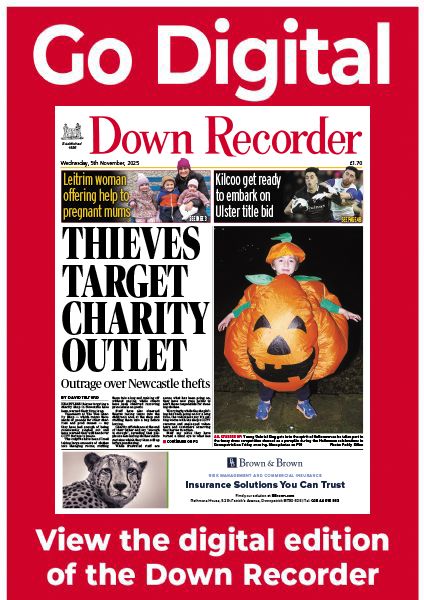Down has the dirtiest beaches in Northern Ireland says new study
Down has the dirtiest beaches in Northern Ireland says new study
26 August 2015
DOWN District beaches are topping a damning poll of the most littered in Northern Ireland.
Ballyhornan beach is the worst according to the three year environmental assessment, with four times as much rubbish as the average, followed by Ardglass. Kilkeel takes third place, followed by the non Blue Flag part of Tyrella beach outside Newcastle.
The local beaches were among 14 assessed by Keep Northern Ireland Beautiful and its report paints the bleakest picture yet of our coastline.
Large swathes of Northern Ireland’s coastline have been branded a litter blackspot, with recyclable plastic the biggest offender. In 2014 an average of 5,332 items was found per kilometre compared to 3,498 in 2013. An average of 1,500 bits of plastic, 425 plastic drinks bottles and 180 cotton buds can now be found on every kilometre of sand and shore according to the charity’s survey. And with at least 80 per cent of the litter being plastic, the potential for recycling this waste is clear.
In Ballyhornan, there was an average of 20,050 items found per kilometre.
This included around 5,000 little pieces of plastic less than one-inch long, nearly 400 heavy duty rubber gloves, over 500 tin cans and nearly 2,000 plastic bottles and caps.
Ardglass, although mostly covered by high tides, held 10,770 items of rubbish. In Kilkeel there were 9,273 and in Tyrella 9,115.
On the north coast the worst performing beach was White Park Bay with 7,168 items and the best performing overall was Hazelbank on Belfast Lough with 418 items.
In Tyrella the council maintains the uncluttered Blue Flag beach, But the charity warned that only 500 metres from designated swimming spots about double the average amounts of rubbish are clearly visible.
The figures were collected at stretches of shore and beach not known for their amenities or given Blue Flag status. They were examined as part of a European requirement to monitor the amount and impact of litter in the sea, where it kills wildlife and damages boats.
The amount of plastic on local beaches is on a par with what is being recorded across Europe. The Northern Ireland survey showed the dirtiest beaches were those nearest to fishing harbours, however most of the rubbish was not directly related to the industry.
Tyrella had the highest number of volunteer clean ups in Northern Ireland, with 502.5 hours recorded and 520 bags of rubbish collected in 2014. In other good news, the effect the carrier bag levy is also beginning to be seen, with no increase in the number of bags despite the growth in amount of litter overall.
Chris Allen, who managed the survey for Keep Northern Ireland Beautiful, said the results showed we were “trashing” the valuable economic and environmental resources of Northern Ireland’s beaches.
“These are pretty stark figures,” he said. “This report suggests that more litter is being dumped on our beaches, not less. Setting aside the dangers to wildlife, much of our country’s economic prosperity is based on our natural heritage, and we are just trashing it.
“We have world-class beaches in this country. They fly Blue Flags for excellent facilities; they set the scene for enormously successful TV shows; tens of thousands of visitors come to enjoy them, but they are frequently covered in a load of plastic bottles, crisp packets and bits of string. Would you come back? Would you bring your friends?”
Mr Allen added: “Winter storms dumped tonnes of litter onto some beaches overnight, suggesting there is a huge reservoir of litter already in the sea, and we are just adding to it. We must come to terms with the damage we are doing to our own health and prosperity by ping litter.
“Through volunteering programmes such as Live Here Love Here and Coast Care the people of Northern Ireland have demonstrated their appetite to be involved in and making a positive change to the places they enjoy. We support that, and we as a society should encourage it at every opportunity.”
Mr Allen said it was estimated that 80 per cent of the litter on beaches originates from land, which can then wash into rivers and eventually the sea.
“You drop a plastic bottle in Downpatrick, it can end up in a storm drain, a local river such as the Quoile and three months later could end up in Ballyhornan,” he said.
“I don’t think people fully contemplate where their litter can end up.”
In other issues particular to the east and south Down coastline, Mr Allen said that Ballyhornan’s position to the south of Strangford Lough and the positioning of a nearby island meant currents help bring litter on to its beach.
He said the east coast of Northern Ireland was also at a disadvantage compared to the north coast.
“The current around Northern Ireland goes in a clockwise direction so there can be more litter turning up on the east coast.”
The full report can be read at www.keepnorthernirelandbeautiful.org


